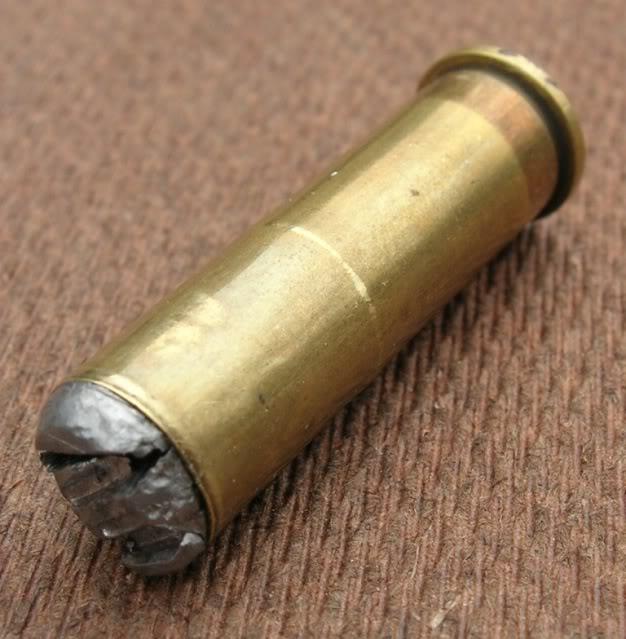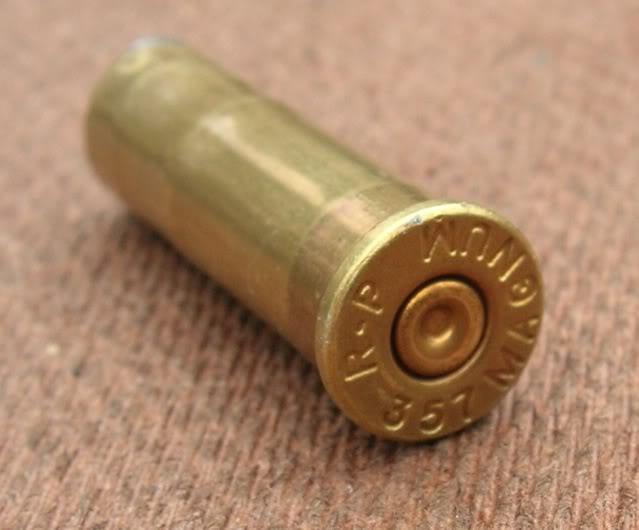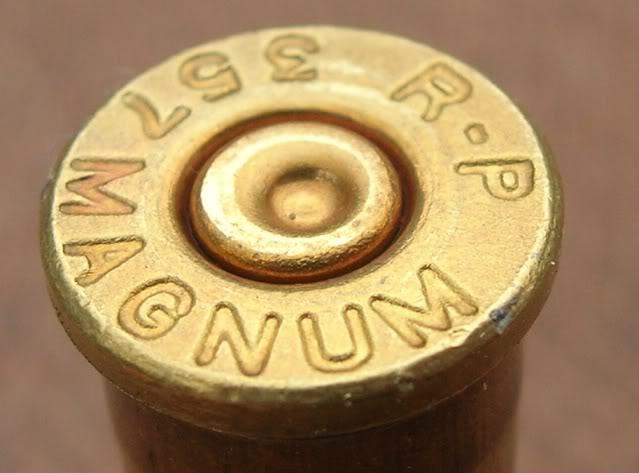-
Legacy Member

I was always taught in my ballistics classes that the "all burned" point should be somewhere around 2/3 of the barrel length! This may apply more to large calibre artillery rounds, but I assume the same should be true for small bore..
Burn rate can change with ambient temperature and pressure, so if the "all burned" point is near to or outside the barrel, then inconsistent ballistics are surely inevitable?
Just for interest, I have just measured a Lebel case capacity.. maximum physical load for N140 is around 51 grains!
Last edited by bombdoc; 11-24-2015 at 06:16 AM.
-
-
11-24-2015 06:05 AM
# ADS
Friends and Sponsors

-
Legacy Member

Well.. I thought I had cracked the non ignition problem by bringing up the load to 44gn.. seemed to work fine for a batch of 50 rounds..
I reloaded to the same spec.. and the first round has failed to ignite! I don't get it.. I don't really want to take the load much more than 44gn and I think I am too close to the maximum loading to switch to magnum primers...
I have Emailed Vithavouri! I think my next move is to change the primer manufacturer..!
-
-
-
FREE MEMBER
NO Posting or PM's Allowed

The cases are normal ball loadings with a standard primer. What happens is that the primer fires, but the powder does not ignite. The bullet is driven into the rifling and the powder is left in a caked lump in the chamber and case. The powder which is normally grey takes on a yellow colour.
Let me recommend something based on my experiences with a revolver: change the mainsprings! You can find new, extra power Mosin Nagant mainsprings at Wolff https://www.gunsprings.com/index.php...ID=102&dID=182 . I have no idea where to find a new mainspring for a French Lebel. You can take measurements of the spring, coil thickness, inside, outside diameter and call Wolff and see if they have something that will fit.
Lebel. You can take measurements of the spring, coil thickness, inside, outside diameter and call Wolff and see if they have something that will fit.
Military rifles have such robust ignition systems that still after a century, with century old mainsprings, they will go bang. However, that does not mean a century later that it is not about time to replace the mainspring. I am of the opinion that weak mainsprings cause ignition problems. This is primarily based on a revolver experience.
One cold weekend I took to the range two recent acquisitions. The first was a well worn S&W M586 and the other a 95% Colt Trooper Mk III both chambered for the 357 Mag.
I bought a very used M586, the previous owned shot PPC with it, said he fired about 40K of 148 LSWC with 2.7 Bullseye and Federal primers. If you are not aware, Federal primers are the most sensitive primer on the market a combination of thin cups and special sensitive priming compound. These primers are outstanding in pistol mechanisms, especially mechanisms with weak or marginal ignition systems. This is an excellent post on this issue: IT DON’T GO BANG: FIRES, HANGFIRES, MISFIRES AND SHORT ORDER COOKS IN JERSEY IT DON’T GO BANG-FIRES, HANGFIRES, MISFIRES AND SHORT ORDER - Gun Hub It turns out, there are a lot of fire arms on the market with marginal ignition systems. Federals will ignite when other primers misfire. While this is a wonderful benefit for revolvers and pistols, it is not an advantage with semi auto rifles. In these mechanisms, Federal rifle primers, standard and match, are the most slamfiring rifle primer on the market.
The weather was cold there were infact snow flakes in the air, it was overcast and the wind was blowing. The ammunition had been overnight in the bed of the truck. With the M586 I had misfires, no hangfires, and I had squibs with a load I tested in 103 F weather. I had rounds that were anywhere between full power and squib. I did not have issues with the Colt Trooper. My load was with a 158 LRN with 12.0 grains AA#9. I used WSP primers. Below is my test data, 12.0 grains AA#9 was close to my “reference” load of 13.5 grs 2400, so that’s what I used.
AA#9 is a very fine ball powder. It shot just fine in warm weather.
One round left a bullet in the throat of the M586, another round left a bullet lodged between the cylinder of the M586 and the throat. The bullet stuck in the M586 throat had a column of ball powder behind it. The texture of the powder was similar to cotton candy. Ball powder was all over the mechanism, I had to get a paper towel and wipe it out from under the extractor star, cylinder recess. Luckily I had a long shafted screwdriver. Inserting the screwdriver through the muzzle and pounding on the handle enabled me to knock the lead bullets out and continue shooting.I have attached pictures of the case that squibed in the M586. As you can see the bullet was shoved back in the case.
I may have had light primer strikes with the 586, but as you can see from the primer on the M586 case, I had deep primer indentations. I have looked at the firing pin protrusion with the M586, and that looks to be good. It protrudes a significant distance out the recoil shield. I loaded this ammunition on a Dillion 550B over a couple of years ago. Out of 100 rounds, these were the only two that stuck in the barrel, but I did have squib rounds.
Shot well, even out to 50 yards. The squib loads barely rocked the gong.
As you can see, the primer looks fairly well smacked.
Tested velocities of my loads in a M27 Smith:
Code:
Smith & Wesson M27-2 6.5” barrel
158 LSWC 13.5grs 2400 R-P cases CCI primers
9-Oct-05 T = 64 °F
Ave Vel = 1273
Std Dev = 44.03
ES = 176.7
High = 1372
Low = 1195
N = 30
Very accurate.
158 LRN 12.0 grs AA#9 CCI500 Mixed cases
5-Aug-06 T = 103 °F
Ave Vel = 1278
Std Dev = 34.98
ES = 117.4
High = 1344
Low = 1226
N = 27
Accurate little or no leading
158 LRN 12.5 grs AA#9 CCI500 3-D cases
5-Aug-06 T = 103 °F
Ave Vel = 1348
Std Dev = 34.16
ES = 134.7
High = 1386
Low = 1251
N = 25
Very Accurate no leading



Instead of mysterious primer issues, mechanical out of tolerance issues, what the real problem turned out to be a combination of a weak mainspring and ball powder. Ball powder is hard to ignite and it is harder to in cold weather. It was not obvious to me that the mainspring was weak, but it had been bent tens of thousands of times shooting PPC by the previous owner. I changed the old mainspring out to a factory new mainspring. Next time I took it out, the weather was 50ish and I had positive ignition and no squibs! I have had absolutely no problems, no misfires, no squibs, with the pistol to date. I have shot hundreds of rounds through the thing since then, no problems at all.
Don't discount my revolver experience, just because it is not a rifle. Primers seem to require a certain threshold of energy for complete ignition. I don't have any data on how much primer energy is released based on striker energy, but based on my pistol experience, I would say it varies.
-
Legacy Member

Thank you for that... I will have a look and see if there is anything I can do with the mainspring. I don't get the impression that it is giving a weak strike; all the primers are showing a good pin impression, and all the primers have gone off.. but as you say, you never know!
What I can't get my head around is how a primer can blow a bullet well into the bore along with a column of powder, and yet not set it off!
The local gunsmith has a pile of Fed primers in so I might just buy a carton or two, even though they take up loads of space...! It might just do the trick!
I WILL crack this! - no answer so far from Vithavouri by the way!
Last edited by bombdoc; 12-10-2015 at 06:34 PM.
-
-
Contributing Member


Why don't you try a different powder (500g one) with equivalent burn rate but again start 5-10% lower than max for that powder see what happens failing that try Federal Match 210M
-
-
Advisory Panel


Don't trouble yourself about striker impact in the Lebel, whose massive striker assembly (firing pin, cocking piece, retainer) weighs a whopping 5.1 oz - compared to 3.0 oz. for a 98 Mauser assembly. Momentum does the trick even if the mainspring is pretty tired.
You'll stop seeing these ignition anomalies when you throw in enough powder to get temperature and pressure up to reasonable levels and/or reduce your expander to give adequate neck tension to those somewhat-undersized bullets.
My Lee 8mm Lebel dies came with an expander appropriate for .323" bullets (perhaps yours didn't). Nevertheless, I experienced ignition problems with conservative loads of IMR4895 in the 40-45 grain range. Once I got up to 48 grains (which about fills the case to the base of my 175-grain bullets), the trouble disappeared.
The Lebel action is massive and robust, made of quality steel, and rated for 50,763 c.u.p. (3500 bar, copper crusher) working pressure - in the same class as the 98 Mauser. There's little rational excuse for doubting its ability to handle stiff loads. Note that Vihtavuori gives 47.5 grains of N140 as maximum in the 8x57 (a smaller case) with the 200-grain Speer bullet.
That much said, if I were seeing ignition problems and didn't have a need for such heavy loads, I'd try a faster powder, preferably double base - with an appropriate lesser charge, of course.
-















 PM
PM













